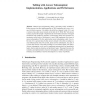Free Online Productivity Tools
i2Speak
i2Symbol
i2OCR
iTex2Img
iWeb2Print
iWeb2Shot
i2Type
iPdf2Split
iPdf2Merge
i2Bopomofo
i2Arabic
i2Style
i2Image
i2PDF
iLatex2Rtf
Sci2ools
JELIA
2010
Springer
2010
Springer
Tabling with Answer Subsumption: Implementation, Applications and Performance
Tabled Logic Programming (TLP) is becoming widely available in Prolog systems, but most implementations of TLP implement only answer variance in which an answer A is added to the table for a subgoal S only if A is not a variant of any other answer already in the table for S. While TLP with answer variance is powerful enough to implement the well-founded semantics with good termination and complexity properties, TLP becomes much more powerful if a mechanism called answer subsumption is used. XSB implements two forms of answer subsumption. The first, partial order answer subsumption, adds A to a table only if A is greater than all other answers already in the table according to a user-defined partial order. The second, lattice answer subsumption, may join A to some other answer in the table according to a user-defined upper semi-lattice. Answer subsumption can be used to implement paraconsistent and quantitative abstract analysis domains, and preference logics. This paper discusses the s...
Answer Subsumption | Artificial Intelligence | JELIA 2010 | Lattice Answer Subsumption | Partial Order |
| Added | 14 Feb 2011 |
| Updated | 14 Feb 2011 |
| Type | Journal |
| Year | 2010 |
| Where | JELIA |
| Authors | Terrance Swift, David Scott Warren |
Comments (0)

